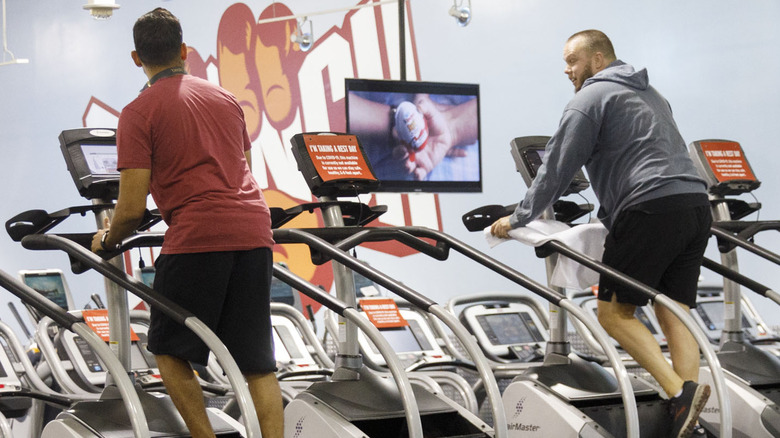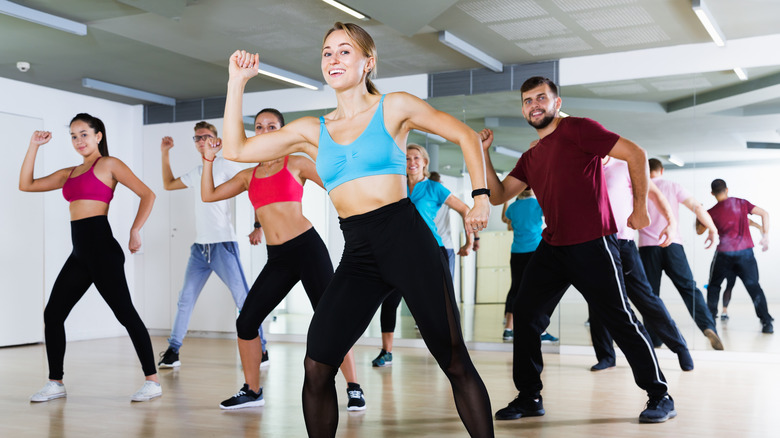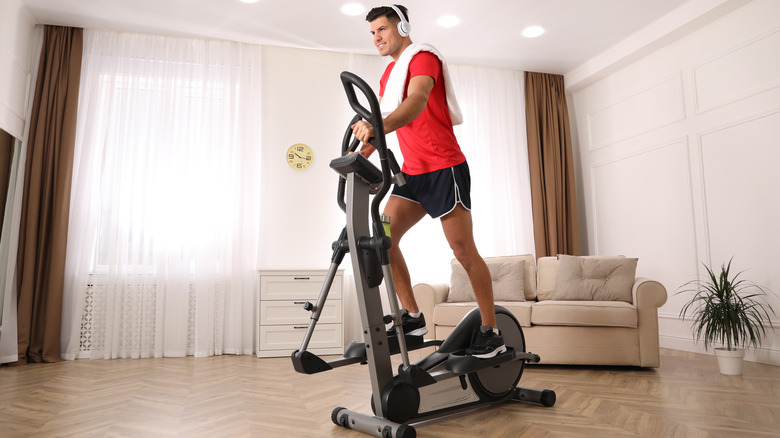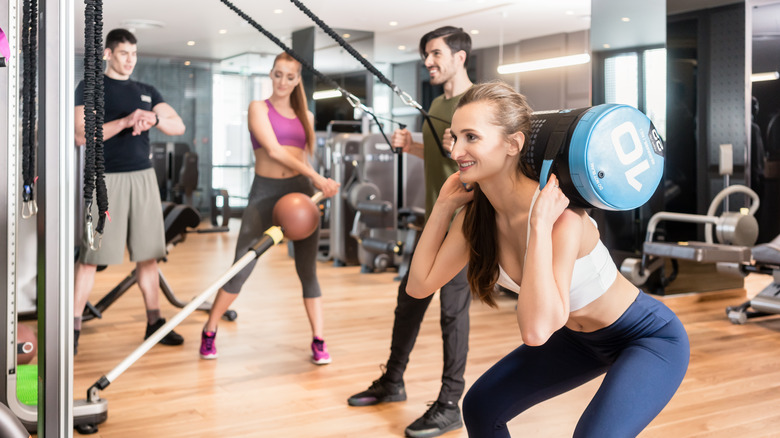The Best Exercises To Get Rid Of Love Handles
Everything is going according to plan. Since cutting calories and walking three miles a day, you're getting fit and losing weight. But those pesky love handles just won't budge! So, what exactly are love handles anyway? Simply put, love handles — also referred to as a muffin top, spare tire, breadbasket — are conspicuous deposits of excess fat jetting out from the sides of one's waistline. Love handles are considered subcutaneous fat, or fat located immediately below the skin. Subcutaneous fat (as opposed to the hidden more dangerous visceral fat) accounts for about 90% of total body fat, as reported by Science Direct.
A common misconception is that you can reduce these fat deposits through spot reduction — using isolated exercises to burn fat in specific areas of the body. The prevailing consensus, however, is that only whole-body, systematic workouts (such as aerobic exercises) are effective at decreasing body fat stores. Nonetheless, some studies, such as a 2021 study published in the International Journal of Environmental Research and Public Health, challenge this long-standing tenet. Spot reduction via targeted exercises (crunches) for the abdomen was shown to significantly reduce abdominal subcutaneous fat; however, dumbbell overhead triceps extensions did not do the same for the triceps area. Other studies show conflicting results as well.
In the end, as suggested by the results of a 2021 study in the journal PLOS Medicine, a total-boy workout that combines aerobic exercise with resistance training is the most effective way to slim down. So when it comes to your workout routine, it may be time to up the ante and melt away those love handles with any of the following more impactful exercises.
Sprint interval training
When it comes to burning excess body fat — including those pesky love handles — it's hard to beat all-out sprinting. Sprint interval training (SIT) is a more intense version of high-intensity interval training (HIIT). According to the American College of Sports Medicine, HIIT — a demanding though time-efficient workout — generally involves an intense effort (like running cycling, swimming) that lasts from five seconds to eight minutes and which gets your heart pumping at 80-90% of its estimated maximal rate. The effort is best described as "hard" to "very hard." The recovery period may be either rest or low-intensity exertion at 40-50% of maximal heart rate, lasting just as long as the intense interval.
Sprint interval training (SIT) takes HIIT to another level. The intensity level in sprint intervals, as described in a review published in a 2021 edition of the International Journal of Environmental Research and Public Health, is usually "all-out" or "supramaximal." In a typical SIT workout, the participant performs at least 4 cycles of all-out sprints for about 30 seconds with a longer recovery period of about four minutes.
In a 2014 study in Applied Physiology Nutrition and Metabolism, SIT for six weeks induced an impressive 8% fat loss (nearly 3 pounds) in young healthy women. Additional study outcomes included about a 1-inch reduction in waist circumference and an increase of 1.3 pounds of fat-free mass (likely muscle). Amazingly, this was all accomplished with only six to nine minutes of actual training per week (45 minutes over six weeks).
Spinning
As described in a field study published in a 2009 edition of Sport Sciences for Health, spinning (indoor cycling classes) is another form of high-intensity interval training that continues to grow in popularity. Led by an instructor, participants on stationary bikes perform routines that simulate outdoor biking and are choreographed to music. Among various types of spinning classes, the Interval Energy Zone class targets performance, fitness, and weight loss. Cyclists aim for a target heart rate between 65% and 92% of their maximal heart rate during two- to four-minute stretches of low or high intensity. The cycling frequency is between 80 and 110 rpm during low-intensity flat stretches and ramped down to 60 to 80 rpm during high-intensity hill bouts. Cyclists can adjust their rpm or the bike's resistance as desired. Nevertheless, since spinning is a very intense exercise, it is better suited for active, fit people rather than individuals who are sedentary, older, or have health problems.
Spinning was remarkably more effective than continuous bicycling at reducing body fat and improving physical fitness in female middle school students, as reported in a 2021 study in the Journal of Exercise Rehabilitation. The study authors pointed out that spinning burns twice as many calories as general bicycling when both exercises are performed at the same intensity. It was concluded that spinning is an exceptional exercise for the preventing obesity as well as improving aerobic capacity, muscular strength and endurance, flexibility, and agility.
Swimming
Swimming is a great aerobic exercise to enhance fitness and burn a lot of calories without adding stress to your joints. The American College of Sports Medicine recommends swimming as an enjoyable activity for people of all ages to enhance cardiovascular health and build muscular strength and endurance. Since swimming is low impact, it's particularly useful for physical rehabilitation because water acts as a protective cushion for joints and bones, reported WebMD. This cushioning effect of water gives swimming an advantage over land-based workouts with respect to lowering the risk of injury as well as post-injury recovery, as noted in a 2014 study in the Journal of Human Kinetics.
Like running and cycling, swimming can be adapted to a high-intensity interval format. A 2017 analytic review in the American Journal of Lifestyle Medicine concluded that swim interval training provides the same superior training benefits of HIIT, with the added benefit of diminished musculoskeletal stress.
According to a 2010 study in the journal Metabolism, swimming improves the distribution of body fat in such a way that abdominal fat is reduced — which is crucial because belly fat is more dangerous to your health than total body fat. Indeed, studies cited in Science Direct suggest that central body fat distribution is linked to a higher risk of developing diseases such as diabetes, heart disease, and cancer.
Running/jogging
If you're not into high intensity sprinting or cycling, good 'ole running or jogging can certainly do the trick as well. For decades, running/jogging has been a popular mode of aerobic exercise aimed at improving overall health. As reported in an historical account published in a 2015 edition of the journal Cultural Geographies, jogging emerged in America in the 1960s as a way to improve physical fitness, predicated on the near universal ability to run. Jogging was encouraged by medical experts to counter the adverse health impacts of modern-day sedentary living.
According to a 15-year assessment of leisure-time running reported in a 2014 edition of the Journal of the American College of Cardiology, even running at lower "doses" (5-10 minutes per day) and slower speeds (less than 6 mph) is linked to marked reduction in deaths from cardiovascular disease as well as risk of dying from all causes.
So, what about fat loss? Not unexpectedly, a 2015 systematic review of 49 randomized controlled trials in healthy adults (18-65 years old) published in the journal Sports Medicine found that one year of habitual endurance running resulted in improvement in various indices of health, including a marked reduction in body fat. Prolonged running at low intensities utilizes fat for fuel at a high rate, thus accounting for the fat loss.
Jumping rope
As reported in Men's Health, jumping rope is a cardio exercise that engages multiple muscle groups (such as the calves, thighs, hip flexors, and glutes), as well as your core. Accordingly, when performed for an hour, jumping rope can burn between 800 and 1000 calories. Once you master the basic jump, you can be more adventurous and learn more advanced techniques such as the crossover, alternating legs, and double under. Adding resistance by using a weighted rope is particularly challenging. Working out with a weighted jump rope three to four times per week for 20-30 minutes will jack up the calorie burn. In addition to its fitness and fat loss benefits, jumping rope is beneficial for improving coordination, agility, and stamina.
Since jumping or skipping rope is an accessible activity for most children — demanding only one piece of relatively inexpensive equipment — it offers them a fun way to improve physical fitness and manage body weight. Indeed, body fat and waist circumference were significantly reduced in obese adolescent girls following a 12-week jump rope exercise program, as demonstrated in a 2019 study published in the Journal of Pediatric Endocrinology and Metabolism.
Stair climbing
Raising your body weight against gravity when climbing stairs, even for brief periods, can be quite a vigorous undertaking. To that end, stair climbing is a great cardio workout that may lower disease risk. In fact, a 2021 controlled study published in the International Journal of Environmental Research and Public Health demonstrated that walking up and down stairs at home reduced disease health risk factors, including excess weight and body fat, in sedentary women.
Stair climber machines simulate actual stair climbing and may also be used either at home or in the gym. Compared with the treadmill, stair climbers are low impact and may be a preferred workout for people with joint disorders, reported Livestrong. For optimal training effects from using a climbing machine, proper posture is important. Standing straight enables you to support your full body weight. Avoid leaning forward; this may indicate the intensity is too high. The standard recommendation is to aim for a moderate level of intensity, regardless of how fit you are.
Group aerobic classes
For various reasons — increased motivation, opportunities for socialization, and just plain fun — many active people prefer to workout in a group setting (via Better by Today). And why not?! Group fitness classes can be great fun while also aerobically challenging and health enhancing. The 2018 edition of the Physical Activity Guidelines for Americans entourages participation in group aerobics classes as an alternative way to improve physical fitness. These group classes may include diverse activities such as choreographed dance classes, water aerobics, step aerobics, and chair aerobics.
Zumba Fitness — a popular dance exercise class set to upbeat Latin music — has been shown to significantly reduce body fat. For example, when performed three times per week for 16 weeks, the popular dance workout Zumba Fitness was shown to significantly decrease body weight and fat mass in physically inactive and working women, per a 2019 study published in the International Journal of Environmental Research and Public Health.
Elliptical training
Among the many exercise machines in gyms, the elliptical trainer is often very much in demand (via Healthline). According to the Mayo Clinic, the elliptical trainer provides a great aerobic workout with less stress on the knees, hips, and back when compared with a treadmill workout. With moveable upper body handles, the elliptical provides a total-body workout. Moreover, the ability to pedal in reverse can give your calves, hamstrings, and glutes that extra burn. As with other machines such as the stair climber, good posture is important for getting the best results. Stay upright with shoulders back; look forward, not down, and avoid leaning on the handles.
Per Healthline, elliptical training, like all aerobic activities, can promote fat loss when paired with a high-protein, low-calorie diet. Workouts on the elliptical machine can be adapted to both high-intensity interval training and steady-state cardio. You will burn more calories and speed up fat loss if you opt for the more intense interval training option.
Rowing
Olympic rowers are among the world's fittest athletes. This is not surprising since research published in a 2014 edition of the Journal of Human Kinetics underscores the very physically demanding nature of rowing, which requires the utmost strength and endurance. In competitive rowing, the initial spurt and final dash require anaerobic power, which accounts for 20-30% of the total energy required in a 2,000-meter race. Anaerobic power generally correlates with muscular strength; hence, the use of rowing machines in fitness centers for improving both aerobic capacity and muscular strength is growing in popularity.
Rowing engages most of the body's major muscle groups, resulting in greater calorie burning compared with activities that recruit only upper or only lower body muscle fibers. In fact, a 2016 study published in the Scandinavian Journal of Medicine and Science in Sports found that fat burning (oxidation) is higher during rowing compared with cycling exercise across a range of exercise intensities.
Circuit training
As described by ScienceDirect, circuit training is a full-body workout that incorporates a variety of exercises (8-10) in a rotation scheme with a brief rest interval in between. Exercise examples include push-ups, squats, lunges, sit-ups, jumping jacks, and shuttle runs (running back and forth between two points). Circuit training can improve both muscular strength and endurance. While the aerobic exercises like the shuttle run provide a stimulus strong enough to enhance cardiovascular health, the resistance exercises increase both upper and lower body muscular strength.
Excess body fat can have serious adverse effects on health, including the development of metabolic syndrome — a grouping of risk factors that increase your chances of cardiovascular disease, type 2 diabetes, and stroke (via Mayo Clinic). Exercise is essential in the prevention and treatment of obesity, the earlier the better. In a 2018 controlled clinical trial reported in the Journal of Exercise Rehabilitation, 12 weeks of circuit training significantly decreased body weight, body fat percentage, and waist circumference in obese female college students.
Kettlebell workouts
Kettlebell workouts are becoming so popular that even diehard iron pumpers are giving it a try. One reason is that, according to Livestrong, a kettlebell workout imparts both cardio and muscle strength benefits, both of which can accelerate fat burning. It's especially great for working your abs since you are compelled to stimulate your core muscles.
The use of kettlebells — cannonball-looking weights made from cast iron or steel — dates back to at least the 1700s and became a popular training method in 18th- and 19th-century Russia and Germany, reports the Cleveland Clinic. The early 2000s saw a resurgence of kettlebell training in the U.S., and the activity's popularity further increased during the pandemic lockdowns. Since swinging a kettlebell engages the entire body, it can suffice as your only workout for the day. Training with a kettlebell two to three times a week is recommended; it's best to start with a light kettlebell and work your way up to heavier kettlebells as tolerated. While watching training videos can help you master the movements, beginners should ideally consider getting proper instruction from a certified trainer. Kettlebell training is safe for most people when using proper mechanics.
Resistance training
As described by Men's Health, resistance training refers to strength-building exercises that compel your muscles to work against and overcome a weight or force. The most common types of resistance are free weights, weight machines, bands, kettlebells, and bodyweight. Compound exercises (bench press, squats, rows, deadlift) that engage multiple muscle groups can serve as your core workout. Aim for three to four sets per exercise and 8-12 reps per set. Training frequency can be three days or even six days a week, provided you allow sufficient recovery time (at least one day) for each muscle group.
While resistance training is the preferred type of exercise for building muscle mass and strength, it can enable fat burning as well. A 2021 study in nearly 12,000 obese adults published in the journal PLOS Medicine found that resistance training protected against excessive fat accumulation and was independently associated with a significantly reduced risk of developing obesity. Specifically, resistance training helps preserve and/or increase metabolically active muscle mass, thus increasing basal metabolic rate and boosting calorie burning. Moreover, the higher metabolic rate persists for up to 24 hours after the exercise session, imparting an "afterburn" effect that drives additional calorie burning. Per the American College of Sports Medicine, this afterburn effect is known as Excess Post-Exercise Oxygen Consumption, or EPOC.













